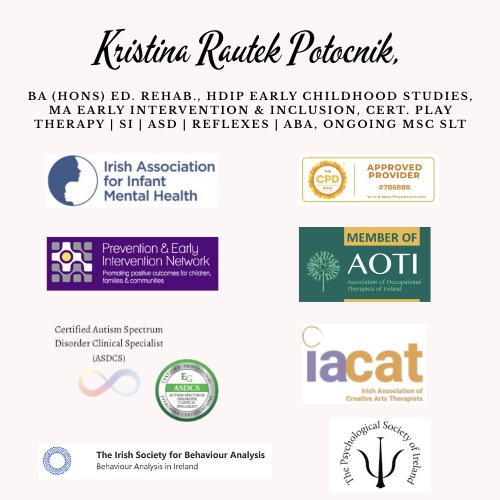Three Steps to Setting Boundaries – with Love and Consistency

Author: Kristina Rautek Potocnik, BA (Hons) Ed. Rehab., HDip Early Childhood Studies, MA Early Intervention & Inclusion, Cert. Play Therapy | SI | ASD | Reflexes, ongoing MSc SLT
Three Steps to Setting Boundaries – with Love and Consistency
Today we hear a lot about setting boundaries – with children, with other people, and even with ourselves. But we often forget to ask the most important question: why are boundaries important?
In parenting, boundaries are not about punishment. They are about safety. Children feel safe when they know that their parent is in control, calm, and knows what to do. Boundaries show children that they are not alone, that someone is there to help them and take care of them.
Boundaries give children space to explore the world, but also help them feel secure.
When can we give choices, and when must we be firm?
In everyday life, it’s great to give children small choices. This helps them feel confident and independent. For example:
Do you want to wear a dress or leggings today?
Do you want to eat a sandwich or porridge for dinner?
But some situations are not safe for choices. For example:
Running on the road.
Playing in dangerous places.
Using screens too much.
Eating too many sweets.
In these moments, parents must be clear and firm. These boundaries protect children and show them what is important.
How to set a boundary: Example – throwing toys
Here is a simple and calm way to set a boundary in three steps:
Step 1: The child throws a toy. You pick it up and say: "Toys go in the box or we play with them."
Step 2: If the child throws the toy again, you pick it up and say: "Toys go in the box or we play with them. If you throw it again, I will take it away."
Step 3: If the child throws the toy again, you take it and put it somewhere they can’t reach. You say: "You threw the toy. Now I will take it."
Use a calm and clear voice. Don’t shout. Be strong and kind at the same time.
The child may cry, get angry, or lie on the floor. This is normal. They are learning how to deal with big feelings. Your job is to stay calm and consistent.
Setting boundaries with time warnings
Children accept changes better when they know what is coming next. For example, at the playground you can say:
"We will play for 10 more minutes."
"We have 5 minutes left."
"Now it’s time to go home."
If the child starts crying or says no, you can say: "I see you had fun, and it’s hard to leave. I understand. But now we are going home."
This way, you show love and understanding, but also keep the rule. The child learns that their feelings are okay, but the limit still stands.
In the end…
Setting boundaries is not always easy. Some days are harder than others. And that’s okay.
What matters most is not to be perfect – but to be calm, consistent, and caring. Every time you set a clear and kind boundary, you help your child feel safe and loved.
Boundaries are not the end of freedom. They are the beginning of trust.
Latest Posts
- How children make sense of the world through their senses
- How your baby learns about the world through their senses
- Helping your child grow stronger through movement and play
- Understanding How Early Intervention Helps Children Learn, Move, and Connect
- How to Recognise Tactile Defensiveness and Help Your Child Feel Safe
- Understanding Feeding Challenges and How to Support Your Child at Home
- Let’s Talk Sitting: Exploring Floor Seating Options
- Retained Primitive Reflexes: The Hidden Cause Behind Developmental Struggles
- Where Curiosity Blossoms: How Children's Play Nurtures Growth for All
- Helping Your Child Through Stress: A Gentle Guide for Parents
- Sweet Little Lies – How to Recognise and Respond with Care
- Chores Are More Than Just Tasks – They’re a Tool for Growing Independence, Focus, and Confidence
- How to Help Children Develop Emotional Intelligence
- Blending Technology and Care: How VR Meta Quest Supports Children at NeuroNest
- A simple guide for parents who want to raise confident, happy children
- Setting Boundaries with Love: A Simple 3-Step Guide for Parents
- Understanding Behavior Through the Nervous System
- A Compassionate Lens on Dysregulation in Non-Speaking Autistic Individuals
- Supporting Development Through Movement: The Role of the Swing in Early Intervention
- Blending Tradition and Innovation: How NeuroNest Supports Your Child’s Unique Journey
- When Movement Meets Innovation: Supporting Child Development with GoBalance
- Why Visual Perception Matters for Everyday Life and Development
- Benefits of Chess in Early Intervention
- Building Healthy Nutrition from the Start
- A Journey Back to Your True Self
- Supporting Your Child’s Hand Skills for Confident Writing
- Blending the Best of Both Worlds
- Helping Toddlers Eat Well: A Parent’s Guide
- Why Tummy Time Matters for Your Baby's Development
- Helping Your Child Build Everyday Independence
- Who Are the Disconnected Kids?
- From First Tries to Automatic Habits: Understanding the Stages of Skill Learning
- Why a Child’s Level of Alertness Matters for Memory and Learning
- Early brain development starts before birth
- Why Slowing Down, Adapting Tasks, and Adding Breaks Helps Children Learn Better
- Why ADHD, Autism, Dyslexia and Other Challenges Need a New Approach
- The surprising power of copying in child development
- Books are more than just language tools—they’re powerful allies in sensory and motor development.
- Rethinking sensory support: moving beyond expensive rooms toward everyday understanding.
- Understanding how fear develops in a child’s brain
- Understanding how an early baby reflex can affect your child’s daily life
- A gentle start into baby development through movement and bonding
- A child-centred, research-informed approach that uses the power of play to support communication, emotional regulation, motor development, and meaningful growth from infancy to twelve years.
Our Partners




Our Memberships


